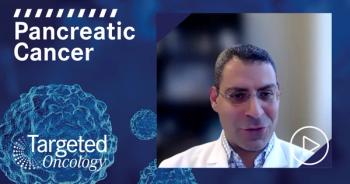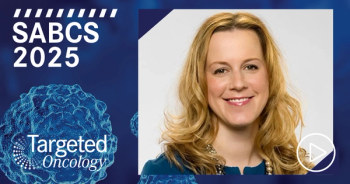
Adding Lenalidomide to Rituximab Consolidation Shows No PFS Improvement in MCL
In an interview with Targeted Oncology, Mitchell Smith, MD, PhD, discussed what the findings from the ECOG-ACRIN E1411 trial in patients with mantle cell lymphoma means for the future of the space, and where research is heading.
The frontline combination of rituximab (Rituxan) plus bendamustine (RB) induction followed by consolidation with rituximab plus lenalidomide (Revlimid) did not demonstrate benefit with the addition of lenalidomide, according to updated results of the phase 2 ECOG-ACRIN E1411 trial (NCT01415752) among patients with previously untreated mantle cell lymphoma (MCL).
In the randomized multi-arm phase 2 trial, bendamustine/rituximab induction followed by consolidation with rituximab plus lenalidomide was evaluated in older patients with MCL. With a longer PFS follow-up of 5.8 years, investigators evaluated the efficacy of the consolidation with the addition of lenalidomide.
Investigators assessed the primary end point of 2-year progression-free survival (PFS) rate and PFS improvement of patients treated with lenalidomide added to a consolidation regimen. Secondary end points of the trial included PET-documented complete response rate, response rate to RB, toxicity, and quality-of-life.
Findings revealed that the 2-year PFS rate by overall treatment was 78% (95% CI, 66%-86%) among patients treated with bendamustine/rituximab plus rituximab consolidation, 78% (95% CI, 66%-86%) for patients given bendamustine/rituximab with bortezomib (Velcade) plus rituximab consolidation, 80% (95% CI, 68%-88%) those receiving bendamustine/rituximab with lenalidomide and rituximab consolidation, and 91% (95% CI, 81%-96%) for patients given bendamustine/rituximab with bortezomib plus lenalidomide and rituximab consolidation.
While this addition of lenalidomide to rituximab consolidation before bendamustine/rituximab induction did not significantly improve the trials primary end point of PFS, bendamustine/rituximab induction in addition to rituximab-based fixed duration consolidation may potentially be a first-line approach for patients with MCL based on a high complete response rate that was observed.
In an interview with Targeted OncologyTM, Mitchell Smith, MD, PhD, chief medical officer of the Follicular Lymphoma Foundation in Washington, DC, further discussed what these findings from the ECOG-ACRIN E1411 trial in patients with MCL means for the future of the space.
Targeted Oncology: Can you discuss the ECOG-ACRIN E1411 trial?
Smith: ECOG ACRIN is one of the United States cooperative oncology groups. There are 3 main ones. In addition to that, there's something called the Alliance for Clinical Trials in Oncology and something called Southwest Oncology Group. This study used all 3 of those plus the NCI Canada cooperative group. So, it was a multi-institutional, multi-cooperative group study across all the US and Canada.
This [phase 2] study was conceived in 2011, so a little more than 10 years ago, and at that time, the initial treatment of mantle cell lymphoma, it's still a bit unclear, but at that time, using a drug called bendamustine along with a monoclonal antibody, rituximab, was common. We call that BR. What is still a bit unclear, even now, was then whether rituximab given additionally as a consolidation of maintenance treatment would be beneficial. We assumed that it would be, and we wanted to see if we could improve on that, so we designed a study that had that as a base, bendamustine plus rituximab for 6 months standard treatment and for induction, and then 2 years of rituximab maintenance or consolidation. Then we asked the question, could we improve on the induction by adding a drug called bortezomib [Velcade], which was known to be active in mantle cell lymphoma and approved for use at that time? Then we asked, could we improve the consolidation by adding a drug called lenalidomide to rituximab, and then there was a fourth arm where they both got the extra drug in induction and in consolidation.
It is a 4-arm study where everyone gets the same base and then 1 group gets bortezomib in induction, 1 gets lenalidomide in consolidation, and 1 gets both. The idea was, could we improve the progression-free survival by 1 or more of those mergers?
What were the eligibility criteria to be included in the study?
We tried to keep the eligibility easy. We got real-world patients. Basically, there was no prior treatment for your mantle cell lymphoma, adequate organ function based on normal kidney, liver, and bone marrow function, and that was pretty much it unless you had a contraindication to 1 of the drugs or something like that. It was pretty simple if [you were] diagnosed with mantle cell lymphoma, [had] no prior treatment, and adequate organ function, you could be registered on the trial.
What were the key findings of the trial?
We reported at ASCO [American Society of Clinical Oncology Annual Meeting], that the addition of bortezomib to BR induction did not significantly benefit the PFS. Now, we've got longer follow-up and we can assess the benefit or not of consolidation with the lenalidomide in addition to the rituximab. And the answer, a bit unfortunate, is that the lenalidomide did not add significantly either, nor did adding both. [This] large study was certainly the first United States-Canadian cooperative group study in MCL, and so we're glad that it was successful. It's paved the way for ongoing trials.
What's also interesting is that the basic treatment—the BR with the rituximab consolidation—did quite well, much better than historical evaluation with BR. So, the median PFS in all of the groups was well over 5 years, close to 6 years. So, I think that's encouraging. When I started in MCL, we used to say survival might be 4, 5, or 6 years and now you get the first treatment, giving that length of PFS. So that's encouraging, and it served as a basis to build further trials.
What are some next steps for either this research or other research like this?
While this study was going on, there was another…major trial started a little bit after ours and it asked the question about a BTK [Bruton’s tyrosine kinase] inhibitor, ibrutinib, which wasn't even around when we designed our trial, but pretty rapidly after, it was shown to be effective in MCL, designed similarly with the BR with the [rituximab] maintenance with the addition of ibrutinib or not, a simple 2 phase. And they found the addition of ibrutinib did prolong the progression-free survival, but their control arm of BR plus [rituximab] was very similar to ours.
So, I think we're getting a feeling that across a number of studies, the basic BR with rituximab for 2 years gives you 5, 6 years. The question in this, what's called the SHINE trial with ibrutinib is whether it is better to have that ibrutinib which you're taking it for 6 or 7 years, or whether you could just get the treatment without the ibrutinib and start the ibrutinib when you progress at year 5 or 6 and get that extra benefit and be saved all the costs and toxicity. That's an open research question that was discussed in the discussion period.
The other question that came up and is a very valid one is the combination of lenalidomide and rituximab in other studies has been quite effective. The question is, why didn't it work better in the study? We did assess the question of dose intensity, we need more analysis, but most patients were able to get the lenalidomide, so we don't think it's that they didn't get the drug or for long enough. There is a concern that the drug bendamustine depletes your T cells and lenalidomide might work in part by a T cell mechanism. It's possible that the lenalidomide/rituximab would work better if you did it later than right after the BR. That's an area that could be explored further.
What are your key recommendations for community oncologists when treating patients with MCL?
The key takeaway is that standard therapy that has been around for over a decade, bendamustine/rituximab with rituximab maintenance, can give many older patients with mantle cell patients a pretty decent PFS of over 5 years. With all the new drugs coming, CAR T cells, bispecific antibodies, new BTK inhibitors, I think the landscape for mantle cell lymphoma has changed significantly. Now there are data out there about new triplets and non-bendamustine. I would take that with a grain of salt because those are small trials as of yet with short follow-up. They're interesting and keep your eye out on them. If there is a clinical trial available, that is great for your patient, but if there is not, BR followed by rituximab is a solid frontline therapy and we can look for all the advances that come down the line by the time your patient needs treatment number 2.











































